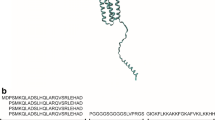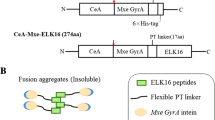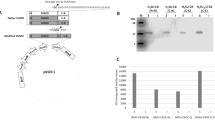Abstract
Antibacterial peptide CM4 (ABP-CM4) is a small cationic peptide with broad-spectrum activities against bacteria, fungi, and tumor cells, which may possibly be used as an antimicrobial agent. To improve the expression level of CM4 in Escherichia coli, two tandem repeats of CM4 genes were cloned into the vector pSUMO to construct an expression vector pSUMO–2CM4. The fusion protein SUMO–2CM4, purified by Ni2+-chelating chromatography, was cleaved by hydroxylamine hydrochloride to release recombinant CM4. After the cleaved sample was re-applied to a Ni-IDA column, finally, about 48 mg recombinant CM4 was obtained from 1 L bacterial culture with no less than 96% purity, which was the highest yield of CM4 reported so far.
Similar content being viewed by others
Avoid common mistakes on your manuscript.
Introduction
The increasing resistance of bacteria and fungi to currently available antibiotics is a major concern worldwide, leading to enormous efforts to develop new antibiotics with new modes of actions [5]. One potential source of novel antibiotics is the antimicrobial peptides which are relatively small molecules that are less than 100 amino acids in length and have a broad spectrum of antimicrobial activity. They serve as an ancient defense mechanism against pathogenic microorganisms that easily come in contact with the host through the environment [4, 11].
Cecropins are positively charged peptides that were originally isolated from the blood lymph of the giant silk moth (cecropins A and B) and, successively, from the small intestine of the pig (cecropin P1). Cecropins have the ability to form specific amphipathic alpha-helices which allow them to target nonpolar lipid cell membranes. Upon membrane targeting, they form ion-permeable channels subsequently resulting in cell depolarization, irreversible cytolysis and finally death [1]. ABP-CM4, an antibacterial peptide isolated from the hemolymph of the silkworm Bombyx mori, belongs to the cecropins family. It is a highly cationic peptide consisting of 35 amino acids and it kills bacteria, fungi, and cancer cells by permeabilizing the cell membrane without being toxic to mammalian cells [3, 12, 13]. Its wide range of activities provides the possibility that ABP-CM4 can be used as an antimicrobial and anticancer agent in the future.
Because of their natural destructive behavior toward microorganisms and relative sensitivity to proteolytic degradation, antimicrobial peptides are often produced by being fused to a fusion partner in heterologous hosts to neutralize their innate toxic activity and increase their expression levels. Many fusion partners have been used to express and purify antimicrobial peptides, including F4 fragment of PurF [7], thioredoxin [14], green fluorescent protein (GFP) [10], and protein PaP3.30 [8]. However, the effects of the affinity tag on different target proteins differ and no affinity tag appears to be generally superior for all recombinant proteins.
In this work, two tandem CM4 genes were fused to SUMO, and the monomer CM4 was obtained by cleaving the SUMO–2CM4 with hydroxylamine that specifically cleaves between the amino acid residues Asn–Gly. The SUMO fusion system and customized expression and purification protocol described here have further improved the efficiency and lowered the costs of producing antimicrobial peptide CM4.
Materials and Methods
Bacterial Strains, Vectors, and Enzymes
Escherichia coli DH5α (maintained in our laboratory) was used for subcloning and plasmid amplification. Escherichia coli BL21 (DE3) (Novagen, USA) was used as the expression host. P. aeruginosa (ATCC 27853) and Penicillium chrysogenum (AS 3.564) were obtained from Institute of Microbiology Chinese Academy of Sciences (IMCAS). E. coli K12D31 was conserved by our laboratory. The linearized pSUMO vector with StuI and HindIII restriction sites was purchased from LifeSensors (LifeSensors, Malvern, PA). All the restriction enzymes and T4 DNA ligase were purchased from Takara Biotech Co. Ltd (Dalian, China).
Construction of Expression Vectors
To obtain a gene encoding two tandem CM4 genes, two oligonucleotides pSUMO-F (5′-TAACGGCCGTTGGAAGATCTTTAAG-3′) and pSUMO-R (5′-CCCAAGCTTTCATTAGTTGATAGTGGCAGCCT-3′) were chemically synthesized. In this primer pair, one hydroxylamine cleavage site (AACGGC) was added to the 5-terminal of pSUMO-F, HindIII (AAGCTT), and stop codons (TCATTA) site were introduced to the reverse primer pSUMO-R. Using this primer pair, the two tandem CM4 genes of interest were amplified from plasmid Trx–2CM4 that was constructed previously by Zhang’s lab [15]. The purified PCR product was digested with HindIII, and ligated into the pSUMO plasmid at the corresponding restriction sites. The ligation mixture was transformed into E. coli DH5α cells for verification by sequencing.
Fusion Protein Expression
The pSUMO–2CM4 plasmid that had been constructed was transformed into competent E. coli BL21 (DE3). Two colonies were picked and cultured in 3 mL LB medium with vigorous shaking (220 rpm) at 37°C to a density of ≈0.6 absorbance unit. Isopropyl-β-d-1-thiogalactopyranoside (IPTG) (0.5 mM) was then added to induce the expression of the recombinant protein at 37°C for 3 h.
Purification of SUMO Fusion Protein
The pellet from 200 mL culture was resuspended in 15 mL binding buffer (20 mM Tris, 500 mM NaCl, 20 mM imidazole, and 10 mM PMSF, pH 8.0), and lysed on ice by sonication at 400 W for 100 cycles (4 s working, 8 s free). The supernatant of the cell lysate resulting from centrifugation at 12,000×g at 4°C for 20 min was applied to a Ni2+-chelating column. After extensive washing with binding buffer, the fusion protein was eluted with five column volumes of elution buffer (20 mM Tris, 500 mM NaCl, and 250 mM imidazole, pH 8.0). The peak fractions containing the fusion protein were pooled and dialyzed overnight at 4°C against phosphate-buffered saline (PBS).
Cleavage of SUMO Fusion and Purification of ABP-CM4
The lyophilized fusion protein was resuspended in cleavage buffer [6] (2 M hydroxylamine hydrochloride, 0.2 M Tris–HCl, pH 9.0) to release the target protein. The pH value of the solution was adjusted to 9.0 with 5 M NaOH. After 4 h incubation at 45°C, the reaction was terminated by lowering the temperature and adjusting the pH with HCl to below 8.0. The cleavage mixture was desalted by dialysis in PBS at 4°C and purified by another affinity chromatography step on Ni2+-IDA-agarose to remove His-tagged carrier and undigested fusion proteins. The purified proteins were checked on Tricine/SDS-PAGE and the samples were stored at −80°C for activity assay.
Assay of Antimicrobial Activity
The antibacterial activities of purified recombinant CM4 was tested by the microbroth dilution method [9] using E. coli K12D31, Penicillium chrysogenum and P.aeruginosa. Briefly, 105–106 colony forming units (CFU)/mL suspended in 100 μL growth medium was mixed with 50 μL recombinant peptide solution in a microtiter plate well with three replicates for each test solution. The 20 mM Tris solution (pH 8.0) was added as the negative control. Microbial growth was assessed by measuring the optical density at 600 nm after 10 h incubation at 37°C. The minimal inhibitory concentration (MIC) was defined as the lowest concentration of peptide at which there was no change in optical density.
Results
Plasmid Construction and the Expression of ABP-CM4 Fusion Protein
The construct for two tandem CM4 genes expression, containing a His-tag for affinity purification, is depicted in Fig. 1. The correct construction was transformed into the expression host E. coli BL21 (DE3), and subjected to a pilot expression test. As shown in Fig. 2, there was an obvious protein band after IPTG induction, and colony 1 was chosen for the induction experiment, and the fusion protein was efficiently produced in a soluble form induced by 0.5 mM IPTG at 37°C.
Purification of SUMO–2CM4 Fusion Protein
As described above, Ni-IDA resin was used for fusion protein purification. Most of the proteins without 6×His tags were removed from the Ni-IDA resin using washing buffer containing 20 mM imidazole, and the 6×His-tagged SUMO–2CM4 (about 23.5 kDa) was eluted using elution buffer containing 250 mM imidazole with more than 90% purity (Fig. 3). About 252 mg fusion protein can be obtained per liter of bacterial culture (Table 1).
Purification of SUMO–2CM4 fusion protein. a Ni-IDA affinity chromatography of fusion protein by using LPDataView (BIORAD). b The eluted fusion protein showed about 90% or more purity by electrophoretic analysis with 12% SDS-PAGE as analyzed by the Bandscan software (BioMarin Pharmaceutical Inc, UK). Lane M molecular weight marker, Lane 1 supernatant of cell lysate, Lane 2 flow-through, Lane 3 wash, Lane 4 elution
Cleavage and Purification of Recombinant CM4
The SUMO–2CM4 protein was competently cleaved with hydroxylamine hydrochloride, confirmed by checking the proteins on a Tricine/SDS-PAGE (Fig. 4, lane 2). After the cleaved sample was re-applied to a Ni-IDA column to subtract 6×His-tagged SUMO and undigested fusion protein, final purified CM4 (about 3.9 kDa) was obtained, and Tricine/SDS-PAGE results indicating that CM4 had been purified successfully with more than 96% purity (Fig. 4, lane 1). Table 2 shown the comparison of the Sumo fusion partner with Trx or Intein fusion partners in production of recombinant CM4. Finally, a purified recombinant CM4 was obtained at a yield of 48 mg/L (Table 1).
Tricine/SDS-PAGE analysis of SUMO–2CM4 fusion protein cleaved by hydroxylamine and recombinant CM4 purification. Lane M low molecular weight marker, Lane 1 purified recombinant CM4 by Ni-IDA, Lane 2: mixture of SUMO–2CM4 fusion protein by hydroxylamine cleavage, Lane 3 purified SUMO–2CM4 fusion protein
Antimicrobial Activity Assays
The antimicrobial activity of the purified recombinant CM4 was evaluated by determining its MICs against selected microorganisms. In this study, the recombinant CM4 had similar antimicrobial properties to the synthetic CM4. The results were shown in Table 3.
Discussion
It has been reported that it is difficult to express cationic antibacterial peptides in engineered bacteria because such peptides are highly toxic to the host bacteria cells and sensitive to intracellular proteases. Fortunately, there problems are somewhat alleviated when expressed with a fusion partner. SUMO is superior to commonly used fusion tags in enhancing expression and solubility [2]. We hypothesize that the attachment of a highly stable and compact SUMO structure to the N-terminus of the CM4 will facilitate correct protein folding and enhance solubility and expression.
In previous report, expression of the recombinant ABP-CM4 has been successfully achieved by constructing the vectors of pET32–nCM4 (n = 1, 2, 3,…,8). It was found that expression levels are not directly proportional to the degree of multimerization. The strains BL21 (DE3)/pET32a–2CM4 or BL21 (DE3)/pET32a–3CM4 could express a higher level of recombinant CM4 than any others [15]. So two and three tandem repeats of CM4 genes were cloned into the vector pSUMO to construct an expression vector pSUMO–2CM4/pSUMO–3CM4. However, in SUMO-mediated peptide expression system, pSUMO–2CM4 could express a higher level of recombinant CM4 than pSUMO–3CM4 (shown in Fig. 4, Supplemental data). So we selected pSUMO–2CM4 for the large-scale expression of recombinant CM4.
In this work, we used hydroxylamine to cleave the fusion protein. Although, there is one additional amino acid (glycine) that attaches at the N-terminus of CM4 after cleavage, our experiments (Table 3) showed that the additional glycine has little effect on characteristics of CM4. One possible reason for this is that glycine is the simplest amino acid and is asymmetric. The side-chain of it is a hydrogen atom which permits a greater degree of conformational flexibility and has the least conformational space of any other amino acid residue. So the conformations of the other amino acids of the peptide are not significantly affected.
In summary, the SUMO fusion system and customized expression and purification protocol described here have greatly improved the efficiency and lowered the costs of producing ABP-CM4. This method has two major advantages over the Trx or Intein fusion systems developed earlier [3, 15]: (1) the protein is purified quickly (2 days vs. 3–5 days); (2) compared with the size of Trx (18 kDa) or Intein tag (54 kDa), the small size of SUMO tag (10 kDa) results in a higher stoichiometric ratio of target polypeptide in fusion protein and, thereby, an increase in polypeptide yields (Table 2). Thus the new protocol provides a higher yield of ABP-CM4 with less time and effort.
References
Boman HG (2003) Antibacterial peptides: basic facts and emerging concepts. J Intern Med 254:197–215
Butt TR, Edavettal SC, Hall JP, Mattern MR (2005) SUMO fusion technology for difficult-to-express proteins. Protein Expr Purif 43:1–9
Chen YQ, Zhang SQ, Li BC, Qiu W, Jiao B, Zhang J, Diao ZY (2008) Expression of a cytotoxic cationic antibacterial peptide in Escherichia coli using two fusion partners. Protein Expr Purif 57:303–311
Kagan BL, Selsted ME, Ganz T, Lehrer RI (1990) Antimicrobial defensin peptides form voltage-dependent ionpermeable channels in planar lipid bilayer membranes. Proc Natl Acad Sci USA 87:210–214
Makovitzki A, Avrahami D, Shai Y (2006) Ultrashort antibacterial and antifungal lipopeptides. Proc Natl Acad Sci USA 103:15997–16002
Moks T, Abrahmsén L, Holmgren E, Bilich M, Olsson A, Uhlén M, Pohl G, Sterky C, Hultberg H, Josephson S (1987) Expression of human insulin-like growth factor I in bacteria: use of optimized gene fusion vectors to facilitate protein purification. Biochemistry 26:5239–5244
Pyo SH, Lee JH, Park HB, Cho JS, Kim HR, Han BH, Park YS (2004) Expression and purification of a recombinant buforin derivative from Escherichia coli. Proc Biochem 39:1731–1736
Rao XC, Li S, Hu JC, Jin XL, Hu XM, Huang JJ, Chen ZJ, Zhu JM, Hu FQ (2004) A novel carrier molecule for high-level expression of peptide antibiotics in Escherichia coli. Protein Expr Purif 36:11–18
Shin SY, Kang JH, Lee DG, Jang SY, Seo MY, Kim KL, Hahm KS (1999) Influences of hinge region of a synthetic antimicrobial peptide, cecropin A(1–13)-melittin(1–13) hybrid on antibiotic activity. Bull Korean Chem Soc 20:1078–1084
Skosyrev VS, Rudenko NV, Yakhnin AV, Zagranichny VE, Popova LI, Zakharov MV, Gorokhovatsky AY, Vinokurov LM (2003) EGFP as a fusion partner for the expression and organic extraction of small polypeptides. Protein Expr Purif 27:55–62
Sugiarto H, Yu PL (2004) Avian antimicrobial peptides: the defense role of beta-defensins. Biochem Biophys Res Commun 323:721–727
Xu J, Zhang SQ (2001) The mechanism of antibacterial peptide CM4 component was observed by confocal laser scanning microscope. Prog Nat Sci 10:1105–1109
Xu J, Zhang SQ (2001) The research of the mechanism of antibacterial peptide CM4 component against A. parasiticus. Prog Nat Sci 11:1263–1267
Xu Z, Zhong Z, Huang L, Peng L, Wang F, Cen P (2006) High-level production of bioactive human beta-defensin-4 in Escherichia coli by soluble fusion expression. Appl Microbiol Biotechnol 72:471–479
Zhou LF, Zhao ZH, Li BC, Cai YF, Zhang SQ (2009) TrxA mediating fusion expression of antimicrobial peptide CM4 from multiple joined genes in Escherichia coli. Protein Expr Purif 64:225–230
Acknowledgements
This work was supported by the Grants of Nanjing Normal University and Jiangsu Province Graduate Innovation Project (No. CX07S-020z) administered by Prof. Zhang. This work was financially supported by National Nature Science Foundation of China (No. 30270193) and Natural Science Foundation of Jiangsu Province, China (No. BK2006221).
Author information
Authors and Affiliations
Corresponding author
Rights and permissions
About this article
Cite this article
Li, J.F., Zhang, J., Zhang, Z. et al. SUMO Mediating Fusion Expression of Antimicrobial Peptide CM4 from two Joined Genes in Escherichia coli . Curr Microbiol 62, 296–300 (2011). https://doi.org/10.1007/s00284-010-9705-3
Received:
Accepted:
Published:
Issue Date:
DOI: https://doi.org/10.1007/s00284-010-9705-3








